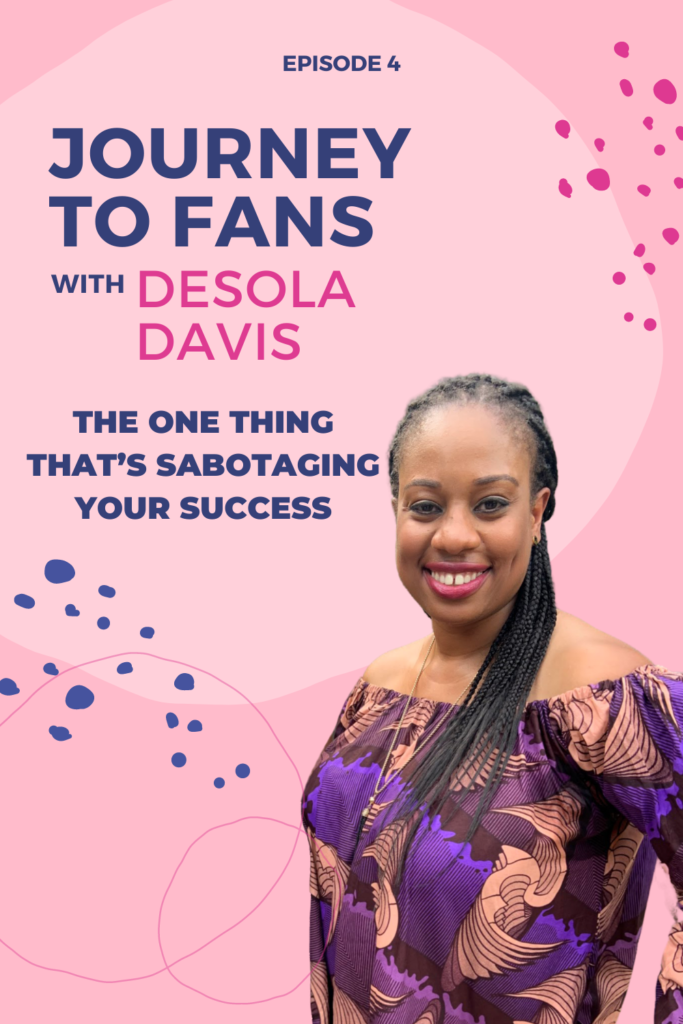Overthinking is the Silent saboteur for business owners
Donald Miller talks about a fundamental difference between incredibly high-performing entrepreneurs and other business owners.
He noticed that it wasn’t that the high-performing entrepreneurs were smarter or were more innovative or that their products were better. It was that they were committed to action. They didn’t let their thoughts get in the way of their progress, which distinguishes them from other business owners that were struggling.
High-performing entrepreneurs also didn’t put so much weight on every single decision that they made in their business. Earlier in my business, I know I had times when it took me ages to make a single decision, simply because I just didn’t want to get it wrong. I also didn’t really exercise the patience to see these decisions through. I pivoted too quickly and honestly, ended up confusing both myself and my audience.
Overthinking doesn’t just happen to people who are confused about their personal direction or the direction of their business. It happens to high performers as well, people who are respected as thought leaders and experts.
And my guess is it’s happened to you, too.

How To Recognize When You're Overthinking
You feel stuck or stagnant
You’re working every day, but you don’t have any idea whether what you’re actually doing is leading to success. You can’t confidently say that the work that you’re putting in today is going to lead you to a goal in the future.
You're pivoting...a lot

This is completely different from being a new business that’s designing a minimum viable product. And you’re changing quickly based on your customer feedback.
That’s not what I’m talking about. It looks more like you’re offering something completely different every month or every quarter, and you’re not giving that offer a chance to land. You feel like you’re playing a guessing game with your audience and you’re not taking any time to actually gather data on what they truly want help with.
You're not sure whether you're meeting your goals
You may also be overthinking in your assessment of success and failure. If you have a faulty way of assessing your business goals, meaning your only metric for success is hitting some arbitrary goal you set for yourself without any real data of how you can realistically achieve that goal, then you may be overthinking.

Why High-Performing Entrepreneurs Overthink
They have not separated their identity from their business
When the business meets its goals, they’re amazing, But then when the product launch flops, they feel like a failure.
They don’t share any of those behind the scenes. They don’t talk about what they’ve learned from failure. They don’t share that even with their clients. And there’s no real in-between. They feel as though their offer isn’t valuable enough.
So then they start seeking external validation. Instead of getting better at what they’re already the best at, they start relying on other coaches or even customers to dictate their own customer journey to dictate the journey to transformation. And they don’t have the confidence to take their rightful place as the expert.
They forgot their why
The second reason that I’ve seen with my clients and other entrepreneurs with regards to overthinking is they’ve simply forgotten the vision for their business, why they started it, or who they plan to serve with it. Somewhere along their journey, they’ve gotten caught up in this rat race of comparison, trying to mimic other people in the industry in an effort to “compete”. Their business doesn’t even look like what they had in mind when they started, and now they feel as though it’s too late to turn back.
They are stuck in survival mode
The third reason entrepreneurs overthink is they fall into something I call the survival trap. In brief, the survival trap is when you’re making long-term business decisions based on short term seasonal circumstances. The most common survival trap that people fall into is when there’s a lack of cash flow in the business. So then they start creating offers that don’t reflect the transformation they want to be known for. And they’re unable to deliver on those offers when the time comes because it’s a direct opposite of their original vision.
And then they come to start building a business that they can’t even recognize.
And unfortunately, sometimes it’s a business that they hate. Now, overthinking is a silent killer because it causes a lose-lose scenario for you as a high-performing business owner.
On the one hand, you keep yourself from making the wrong decision because you want to avoid failure. But on the other hand, you’re also keeping yourself from hitting your goals because you’re not taking any action. So let’s talk a little bit of science. And if you know me, you know, I’m kind of a science geek. So, let’s talk about your brain for a second.
Your brain in fight or flight mode
Your brain is designed to keep you from taking risks because it wants to protect you from danger.
And that’s important, right? If you’re face to face with a lion, a tiger, a bear, or a fly, if you’re me, you want to run away. You want your brain to tell your body what to do to protect itself and that, you know, in that season.
But when you’re faced with a business decision, the fight or flight response is not really necessary.
And so what ends up happening is your brain is trying to protect you from the danger of making a decision, but it’s falling into something called loss aversion bias. Behavioraleconomics.com shares that people would prefer to take more risks to avoid a loss than to make a gain.
The pain of losing has been estimated to be psychologically about twice as powerful as the pleasure of gaining meaning. People remember that pain twice as much as the pleasure of scoring a game. And that makes sense, right?
Because people just don’t like to be in pain.
And so what happens is your brain is wired again to keep you from harm, pain, and danger. But it’s that very mechanism that keeps you from making decisions that move your goals forward. And you might say at this point, well, Desola isn’t that safe. Don’t I want my brain to keep me from making bad decisions? And to that I say, yeah, yes, definitely.
You definitely want your brain to keep you from being reckless with your business. But overthinking is no respecter of decision-making.
It affects both your big business decisions as well as your smaller ones.
How Overthinking Prevents You From Hitting Your Business Goals
In fact, overthinking overestimates the impact of a single action while underestimating the outcome of the momentum that the single action could create.
I’ll say it again, overthinking overestimates the impact of a single action while underestimating the outcome of the momentum that the single action could create. So where it would take you a long time and several actions to think about adding a new income stream to your business, thinking about whether to do a video series, a workshop or a challenge to engage your audience before inviting them to buy should not take you nearly as long.
You shouldn’t have to mull over what way you’re going to invite your audience or your prospects into a working relationship with you. It’s weird because while they’re overthinking these mundane decisions, business owners are also more flippant about the direction that they want their businesses to face at any given moment. They’re offering one thing this month and then something else the next and then another month.
They’re making no offers at all because they’re discouraged by their market response. The deeper they go into this rabbit hole, the less they know about their dream clients and the further away they get from building the business of their dreams.
Interestingly enough, overthinking has a very simple antidote, it’s action. See, I didn’t say it was easy.
I said it was simple.
The Antidote to Overthinking
Instead of focusing on the impact of a minor decision, aim for consistent action, there’s something I tell my clients and I often share this in my talks whenever I am, you know, booked to speak or something like that. It’s that you don’t need confidence to take action.
The more action you take, the more data you generate and the more confident you become about the direction that you’re going in. And I know it’s easy to just say, well, take more action, but how do you actually do that when you’re in the thick of overthinking here? I’m going to share three components of my proprietary strangers to fans goal-setting system. Now, this isn’t the full system, but knowing these three components will help you make better decisions.
The Three Components of Goal Setting
Vision
The components are your vision, your plan and your system. And I’ve lovingly called it the VPS method just to help with remembering. Let’s talk about your vision first. When you’re writing out your vision, the question you’re trying to answer is what type of business are you trying to build?
Who are you becoming as you’re building this business? And why is this important to you personally?
It’s the same thing.
Plan
What are you trying to achieve? Who are you becoming in that process and why is it important to you? This is what you’re going to fall back on when you’re in the middle of working through your goal, when everything is heavy and everything feels difficult, this is what’s going to prevent you from making uninformed decisions and keep you on track to generate momentum. Your plan consists of the three to five milestones that have to be true for your vision to be a reality.
This is where you’re going to break your vision down into smaller goals that give you landmarks to look out for as you progress. So instead of looking at a one-dimensional metric to tell you whether your business is succeeding or failing, these landmarks will show you whether you’re making progress or you need to tweak your system to get more favorable results.
As a matter of fact, your plan is the backbone for your data collection process as you’re progressing towards your goals.
System
Finally, your system is where you’re going to implement that consistent action I’m talking about. This is where that’s necessary here. You’re going to identify what you will do daily or weekly to execute your plan.
Remember, I’m talking about your system here. Your plan or your plan consists of the milestones and so your systems, what you’re going to do daily or weekly to achieve those milestones. How are you going to practically work to reach each of the milestones that you’ve created and progress towards your goal? You see here now, we’re not talking in the ethereal. We’re not talking abstract.
This is something tangible that you’re going to do to make those milestones of reality and over time make that vision a reality as well. These are the actions you’re going to measure to make sure that you’re on the right track.

The VPS in Action
So let’s use an example. Say I want to compete on a complete a 10K before the end of this year. That’s my vision.
In accomplishing this goal, I will ultimately become a runner. I’ll be able to see myself as a runner. I know I’ll feel much better in my body. I’ll make better health, you know, healthier decisions and things like that. So we’re smack in the middle of the year.
We’re in the middle of twenty, twenty one. It gives me a roughly six months to complete it today. I am not confident that I can complete a 10K race, but if I focus on my lack of confidence today that I won’t be motivated to take the action to get in shape for the race. So instead of looking at what I can accomplish today, I’m going to create a plan that will keep me on track to execute my vision. So I have six months.
And so my plan may look like in the next month I want to be able to run one mile without stopping. Maybe in three months. I want to be able to complete a 5K and by month five, I want to be ready for my 10K race.
That’s my plan.
My goal is just to complete the race. So it doesn’t matter what my timing is yet, because I haven’t proven to myself that I can complete the race yet. I have my milestones in place and I can easily collect data to see whether my vision is still within reach. Now that I have my milestones, I need a system that I can implement on a daily basis to set my plan in motion.
So I look up a walk to run on my own training for four weeks and then I stack a 5K training for eight weeks and then I have a plan for a 10K training that I can continue after that. Success for me looks like completing all of my workouts in that training system and I can easily measure it right at the end of the first month. I can check to see if I can run a mile without stopping. And if you’ve ever trained for a race, you know, that is it’s absolutely doable.
After 30 days of consistent training, I fully expect success at this point because I’m going to commit to the consistent action of completing my training.
So on a daily basis, I’m not looking so far ahead at the 10K and saying, well, I only ran fifteen minutes, how can I ever complete a 10K? My goal is just to accomplish that consistent action that’s due today. And if that action is today, we’re going to walk a mile, I’m going to walk a mile because I know that that’s just going to build up on the momentum that I need to be strong enough to complete that 10K race by month five.
And that’s how the VPs method works. I’m clear on my vision.
I have an implementable plan and I have a system that I can execute and measure to make sure that I’m on track.

The Importance of Momentum
Like I said earlier, consistent action leads to momentum. Jon Acuff is another author that I really like. He put it really beautifully in his new book, Soundtrack’s, which incidentally, is about overthinking.
He said momentum is messy. It’s a simple statement. It’s also so freeing to realize that your execution may not go as smoothly as you planned it, but every decision you take is a stepping stone in the direction of your vision.
I always tell my clients ahead of time to expect that the system isn’t going to work exactly as planned. Knowing that the ride’s not going to be smooth frees them from overthinking in the future and it helps them keep their entrepreneurial, quick thinking, agile hats on as they make progress towards their goals.
An example of using momentum and not overthinking
For example, and I’ve told the story before in certain circles, but I tell the story a lot about how I went from zero to 500 leads in 30 days because I decided to host a summit. I want to make sure that you understand that this was not even close to a glamorous feat at all.
The truth is, it was grueling. There was a lot to do in a very short amount of time because I effectively decided to slice my timeline by 60%. You’re supposed to give yourself a 90 day head start to plan and execute your summit. But since I made that decision and I was willing to deal with the consequences.
There was a cost associated with the decision that I made. Some of those consequences were I didn’t sleep very well. I let a lot of things fall through the cracks.
And I didn’t make any profit from this summit. I actually made a loss.
But I did start my own little raving fan base that has since grown from that summit.
And since then, it’s opened up more opportunities for me than I can count. I’m serving larger audiences and sharing spaces with people that I only used to admire from afar.
Now, if I looked at that singular decision in a vacuum and counted it as a failure, I would be missing out on all the ripple effects that have happened and are still happening today.
If I overthought the impact of that decision, I would have significantly underestimated the impact of its outcome. Benefits that I’m still reaping.
So this day, it’s one of the best decisions that I made, even though in that short term it looked like one of the worst decisions that I made. So now I’m going to leave you with a question. What’s one decision in your business or even personally that you’re overthinking?
Why don’t you use the VP system, create your vision, write out your plan and find a system to turn that decision into a commitment to consistent action?
Don’t overestimate the impact of that action.
Just stay committed and measure your progress. Remember, momentum is messy, so we already know up front that the system’s not going to go as planned. Don’t let that stop you tweak it as you go.
